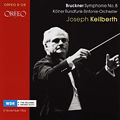ORFEO International – Reviews
Important Releases Briefly Introduced
October 2007
ORFEO 1 CD C 724 071 B
Joseph Keilberth
Although there was a period following his death when Joseph Keilberth’s reputation suffered an eclipse, he is now once again numbered among those conductors of the second third of the 20th century whose work has finally received the attention that it deserves. This change in Keilberth’s posthumous fortunes is due above all to the legen-dary opera performances that he conducted at the Bavarian State Opera and at the Bay-reuth and Salzburg Festivals, a number of which are documented on the Orfeo label. The increasing availability of these recordings has also caused us to revise our picture of Keilberth’s importance as a concert conductor. During his lifetime there was never any doubt about this standing in this area, a standing already evident during his years as music director of the German Philharmonic Orchestra of Prague. Following the Second World War, members of this last-named ensemble formed the nucleus of the Bamberg Symphony Orchestra, which Keilberth helped to found. 
ORFEO CD C 724 071 BAs its principal conductor he took the Bambergers on tour all over the world. His sudden death at the age of only sixty was a bitter blow to the world of music, a loss highlighted by the present reissue of a performance of Bruckner’s Eighth Symphony recorded in 1966 with the Cologne Radio Sym-phony Orchestra (now the West German Radio Symphony Orchestra of Cologne). This was the last occasion on which Keilberth conducted a work that he had performed regularly with various orchestras over a period of twenty-five years. All four movements are characterized by Keilberth’s successful attempt to maintain a flowing musical line while achieving great inner calm, an approach that by no means excludes the occasional speeding up and slowing down but which avoids rushing the fast movements and dragging the slow ones. Dynamically, too, Keilberth’s interpretative decisions are invariably well considered. The string sonorities remain gossamerlight and transparent, while the winds and in particular the brass are given their head only at the most monumental climaxes. As always with Keilberth, the spectacular element and the bombast so fre-quently heard in Bruckner’s music are secondary to a note of delicate intimacy. Each bar bespeaks Joseph Keilberth’s sense of responsibility towards a tradition that he saw as increasingly under threat during his final years of life. All the more gratifying and desirable is it, therefore, to be able to hear and appreciate Keilberth’s seriousness of purpose, which even in Bruckner’s symphonies avoided an exaggeratedly incense-laden mysticism.
top |